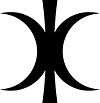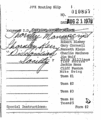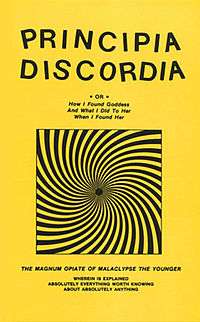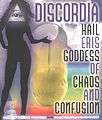Principia Discordia
|
The Loompanics "Yellow Cover" combined 4th & 5th Edition Principia Discordia, (1979). In print until the company went out of business in 2006. | |
| Author | Greg Hill and Kerry Wendell Thornley |
|---|---|
The Principia Discordia is a Discordian religious text written by Greg Hill (Malaclypse the Younger) with Kerry Wendell Thornley (Lord Omar Khayyam Ravenhurst). The first edition was printed using Jim Garrison's Xerox printer in 1963.[1] The second edition was published under the title Principia Discordia or How The West Was Lost in a limited edition of five copies in 1965. The phrase Principia Discordia, reminiscent of Newton's Principia Mathematica, is presumably intended to mean Discordant Principles, or Principles of Discordance.[2]
The Principia describes the Discordian Society and its Goddess Eris, as well as the basics of the POEE denomination of Discordianism. It features typewritten and handwritten text intermixed with clip art, stamps, and seals appropriated from other sources.
While the Principia is full of literal contradictions and unusual humor, it contains several passages which propose that there is serious intent behind the work, for example a message scrawled on page 00075: "If you think the PRINCIPIA is just a ha-ha, then go read it again."
The Principia is quoted extensively in and shares many themes with the satirical science fiction book The Illuminatus! Trilogy by Robert Shea and Robert Anton Wilson. Wilson was not directly involved in writing the Principia.

Notable symbols in the book include the Apple of Discord, the pentagon, and the "Sacred Chao", which resembles the Taijitu of Taoism, but the two principles depicted are "Hodge" and "Podge" rather than yin and yang, and they are represented by the apple and the pentagon, and not by dots. Saints identified include Emperor Norton, Yossarian, Don Quixote, and Bokonon. The Principia also introduces the mysterious word fnord, later popularized in The Illuminatus! Trilogy; the trilogy itself is mentioned in the afterword to the Loompanics edition, and in the various introductions to the fifth editions.
Overview

The Principia Discordia holds three core principles: the Aneristic Principle (order), the Eristic Principle (disorder) and the notion that both are mere illusions. The following excerpt summarizes these principles:
The Aneristic Principle is that of apparent order; the Eristic Principle is that of apparent disorder. Both order and disorder are man made concepts and are artificial divisions of pure chaos, which is a level deeper than is the level of distinction making.With our concept-making apparatus called "the brain" we look at reality through the ideas-about-reality which our cultures give us. The ideas-about-reality are mistakenly labeled "reality" and unenlightened people are forever perplexed by the fact that other people, especially other cultures, see "reality" differently.
It is only the ideas-about-reality which differ. Real (capital-T) True reality is a level deeper than is the level of concept. We look at the world through windows on which have been drawn grids (concepts). Different philosophies use different grids. A culture is a group of people with rather similar grids. Through a window we view chaos, and relate it to the points on our grid, and thereby understand it. The order is in the grid. That is the Aneristic Principle.
Western philosophy is traditionally concerned with contrasting one grid with another grid, and amending grids in hopes of finding a perfect one that will account for all reality and will, hence, (say unenlightened westerners) be true. This is illusory; it is what we Erisians call the Aneristic Illusion. Some grids can be more useful than others, some more beautiful than others, some more pleasant than others, etc., but none can be more True than any other.
Disorder is simply unrelated information viewed through some particular grid. But, like "relation", no-relation is a concept. Male, like female, is an idea about sex. To say that male-ness is "absence of female-ness", or vice versa, is a matter of definition and metaphysically arbitrary. The artificial concept of no-relation is the Eristic Principle.
The belief that "order is true" and disorder is false or somehow wrong, is the Aneristic Illusion. To say the same of disorder, is the Eristic Illusion. The point is that (little-t) truth is a matter of definition relative to the grid one is using at the moment, and that (capital-T) Truth, metaphysical reality, is irrelevant to grids entirely. Pick a grid, and through it some chaos appears ordered and some appears disordered. Pick another grid, and the same chaos will appear differently ordered and disordered.
Reality is the original Rorschach. Verily! So much for all that.
—Malaclypse the Younger, Principia Discordia, Pages 00049–00050
History

The Principia Discordia or How The West Was Lost was first published in a limited edition of five copies and released into the public domain in 1965.[3] The full title of the fourth and most well-known edition is Principia Discordia or How I Found Goddess And What I Did To Her When I Found Her: The Magnum Opiate Of Malaclypse The Younger, Wherein is Explained Absolutely Everything Worth Knowing About Absolutely Anything.Included on page 00075 is the following note about the history of the Principia:
- This being the 4th Edition, March 1970, San Francisco; a revision of the 3rd Edition of 500 copies, whomped together in Tampa 1969; which revised the 2nd Edition of 100 copies from Los Angeles 1969; which was a revision of PRINCIPIA Discordia or HOW THE WEST WAS LOST published in New Orleans in 1965 in five copies, which were mostly lost.
Additionally, the "contents of this edition" note in the Loompanics edition identifies the fourth edition as having originally been published by Rip Off Press of San Francisco, California.
A "Fifth Edition" consisting of a single Western Union telegram page filled with the letter M was published as an appendix to the Loompanics and SJ Games re-printings of the 4th Edition.
In 1978, a copy of a work from Kerry Thornley titled "THE PRINCIPIA Discordia or HOW THE WEST WAS LOST" was placed in the HSCA JFK collections as document 010857.[4] Adam Gorightly, author of The Prankster and the Conspiracy about Kerry Thornley and the early Discordians, said the copy in the JFK collection was not a copy of the first edition but a later and altered version containing some of the original material. In an interview with researcher Brenton Clutterbuck,[5] Gorightly said he had been given Greg Hill's copy of the first edition. This appeared in its entirety in Historia Discordia, a book on Discordian history released in spring of 2014.[6][7]
The Principia includes a notice which purports to disclaim any copyright in relation to the work: "Ⓚ All Rites Reversed – reprint what you like." Regardless of the legal effect of this notice, the Principia has been widely disseminated in the public domain via the Internet and more traditional print publishers. Some re-publishers have claimed copyright in relation to the additional material included in their editions.
Reprints of the Fourth and Fifth Editions:
- Revisionist Press published a red hardcover of the Fourth Edition in 1976, adding a stamp reading "THIS WORK IS A BRIDGE SO MOVE ON THRU" to the right of the golden apple on page 00075. (ISBN 0-685-75085-X)
- Loompanics Unlimited published a version (the "yellow cover version") in 1979, adding an introduction by Robert Anton Wilson, an afterword by Malaclypse the Younger, and the aforementioned "Fifth Edition". (ISBN 1-55950-040-9) This version is reprinted by Paladin Press under ISBN 1-58160-547-1.
- Steve Jackson Games published a version (the "black cover version") in 1994, adding an introduction by Steve Jackson and 20 pages of new Discordian text, mostly collected from online Discordians. (ISBN 1-55634-320-5) Steve Jackson Games also publishes Discordian and Illuminati-inspired games, such as GURPS Illuminati and the Illuminati card game.
- Ronin Publishing released a completely re-edited version in 2006 (ISBN 1-57951-029-9), under the title Discordia - Hail the Goddess of Chaos and Confusion. This edition features a co-credit on the cover for both Malaclypse and Ravenhurst, a colour cover, numerous typographical errors, and is 192 pages in length. Most of the original artwork was replaced with low-quality clip-art.
 NARA Cover sheet for the alleged First Edition
NARA Cover sheet for the alleged First Edition "Yellow cover"
"Yellow cover"
Loompanics Unltd, 1979 "Pink" or "Purple cover"
"Pink" or "Purple cover"
IllumiNet Press, 1991 "Black cover"
"Black cover"
SJ Games, 1994 Discordia: Hail Eris Goddess of Chaos and Confusion
Discordia: Hail Eris Goddess of Chaos and Confusion
Ronin Press, 2006 "Snake cover"
"Snake cover"
Synaptyclypse Generator, 2007
Mythology
In Discordian mythology, Aneris is described as the sister of Eris aka Discordia. Whereas Eris/Discordia is the Goddess of Disorder and Being, Aneris/Harmonia is the Goddess of Order and Non-Being.
"DOGMA III – HISTORY 32, 'COSMOGONY'" in Principia Discordia, states
- In the beginning there was VOID, who had two daughters; one (the smaller) was that of BEING, named ERIS, and one (the larger) was of NON-BEING, named ANERIS.[8]
The sterile Aneris becomes jealous of Eris (who was born pregnant), and starts making existent things non-existent. This explains why life begins, and later ends in death.
- And to this day, things appear and disappear in this very manner.[8]
The names of Eris and Aneris (who are later given a brother, Spirituality), are used to show some fundamental Discordian principles in "Psycho-Metaphysics":
- The Aneristic Principle is that of APPARENT ORDER; the Eristic Principle is that of APPARENT DISORDER. Both order and disorder are man made concepts and are artificial divisions of PURE CHAOS, which is a level deeper than is the level of distinction making.[9]
Discordian works
References
- ↑ Wilson, Robert Anton (1992). Cosmic Trigger I: Final Secret of the Illuminati. Scottsdale, AZ: New Falcon Publications. p. 65. ISBN 978-1561840038.
- ↑ In Latin, discordia is not an adjective. It can be a singular noun by itself, meaning "discord", or, like principia, be the plural of a noun – discordium, also meaning "discord". In either case, the phrase consists of two juxtaposed nouns without a grammatical relationship.
- ↑ Frauenfelder, Mark (November 1, 2006). "Publisher alters, then copyrights Principia Discordia". Boing Boing.
- ↑ The record identifier can be found by searching for Thornley and Discordian on nara.gov. "Kennedy Assassination Collection: Discordian Socity [sic]". National Archives and Records Administration. Retrieved 17 February 2012.
- ↑ "Wikinews interviews Brenton Clutterbuck". Wikinews. Retrieved 29 August 2013.
- ↑ "Adam Gorightly presents the COMPLETE first edition Principia Discordia". Retrieved 29 August 2013.
- ↑ Adam Gorightly: "Historia Discordia" (2014). ISBN 1618613219
- 1 2 "Page 56". Principia Discordia. Retrieved 2012-08-19.
- ↑ "Internet Archive Wayback Machine". Web.archive.org. 2009-10-27. Archived from the original on October 27, 2009. Retrieved 2012-08-19.
External links
| Wikiquote has quotations related to: Principia Discordia |
| Wikisource has original text related to this article: |
Online versions
- The original text version − Principia Discordia on www.cs.cmu.edu or Principia Discordia on www.ology.org